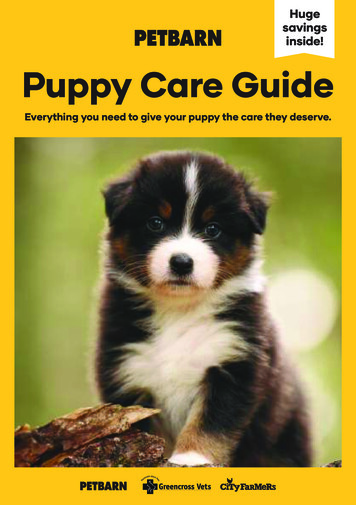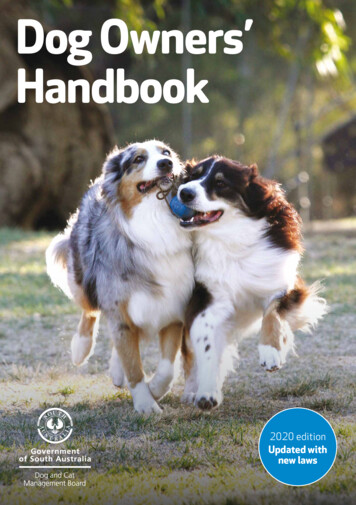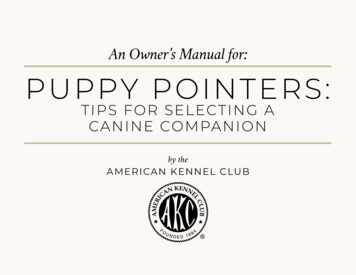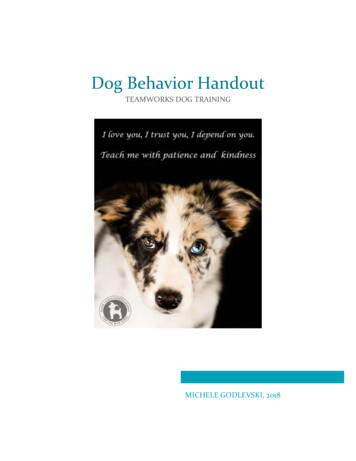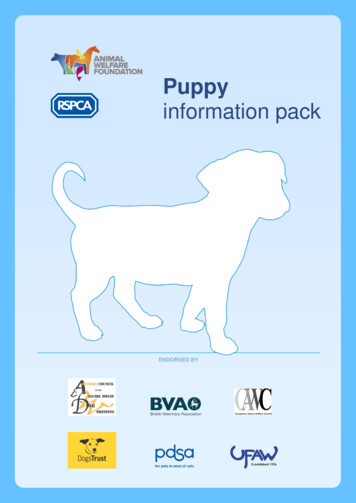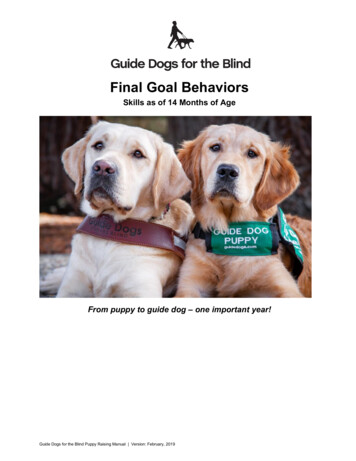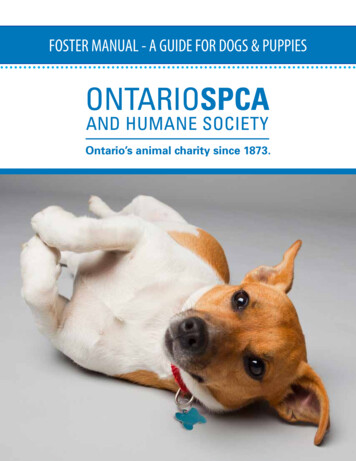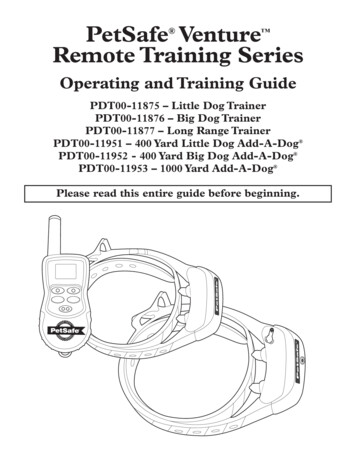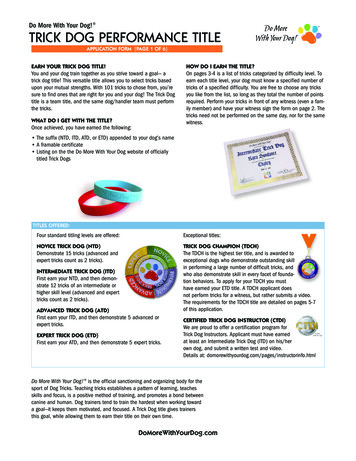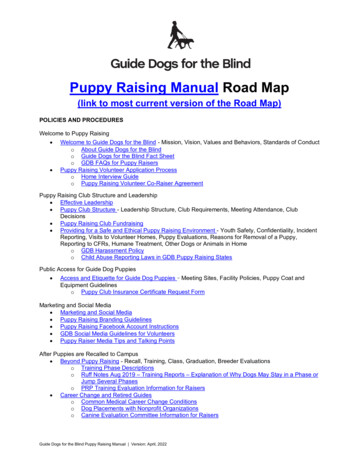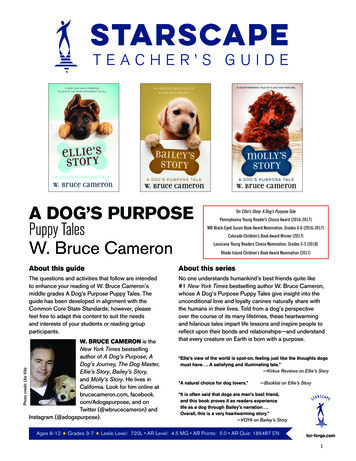
Transcription
TEACHER’S GUIDEPhoto credit: Ute VilleA DOG’S PURPOSEPuppy TalesW. Bruce CameronOn Ellie’s Story: A Dog’s Purpose TalePennsylvania Young Reader’s Choice Award (2016-2017)MD Black-Eyed Susan Book Award Nomination, Grades 4-6 (2016-2017)Colorado Children’s Book Award Winner (2017)Louisiana Young Readers Choice Nomination, Grades 3-5 (2018)Rhode Island Children’s Book Award Nomination (2017)About this guideAbout this seriesThe questions and activities that follow are intendedto enhance your reading of W. Bruce Cameron’smiddle grades A Dog’s Purpose Puppy Tales. Theguide has been developed in alignment with theCommon Core State Standards; however, pleasefeel free to adapt this content to suit the needsand interests of your students or reading groupparticipants.No one understands humankind’s best friends quite like#1 New York Times bestselling author W. Bruce Cameron,whose A Dog’s Purpose Puppy Tales give insight into theunconditional love and loyalty canines naturally share withthe humans in their lives. Told from a dog’s perspectiveover the course of its many lifetimes, these heartwarmingand hilarious tales impart life lessons and inspire people toreflect upon their bonds and relationships—and understandthat every creature on Earth is born with a purpose.W. BRUCE CAMERON is theNew York Times bestsellingauthor of A Dog’s Purpose, ADog’s Journey, The Dog Master,Ellie’s Story, Bailey’s Story,and Molly’s Story. He lives inCalifornia. Look for him online atbrucecameron.com, facebook.com/Adogspurpose, and onTwitter (@wbrucecameron) andInstagram (@adogspurpose).“ Ellie’s view of the world is spot-on, feeling just like the thoughts dogsmust have . A satisfying and illuminating tale.”—Kirkus Reviews on Ellie’s Story “A natural choice for dog lovers.” —Booklist on Ellie’s Story“ It is often said that dogs are man’s best friend, and this book proves it as readers experience life as a dog through Bailey’s narration . Overall, this is a very heartwarming story.”—VOYA on Bailey’s StoryAges 8-12 H Grades 3-7 H Lexile Level: 720L AR Level: 4.5 MG AR Points: 5.0 AR Quiz: 185487 ENtor-forge.com1
Ellie’s Story: A Dog’s Purpose TaleEllie’s Story: A Dog’s Purpose Tale describes the life of asearch-and-rescue dog, but its unique viewpoint makes ita fantastic resource for children and adults who love dogssimply as pets, too. From puppyhood, to bonding withhumans, to working to save lives, readers of all ages will begripped by Ellie’s story and its insights into humankind’sbest friends.READING WITH YOUR CHILDRENBEFORE READINGTHE BOOK:Discussion QuestionsHelp your young reader get excited about this book byexploring key words and ideas from the story. This will helpstrengthen the connections children make as they begin toread. This book is titled Ellie’s Story. What is a “purpose”?What types of roles do dogs play in your community?What do you think is a dog’s most important role? What books have you read about dogs? Describe yourfavorite dog book, noting whether it was fiction or nonfiction, and what you liked best about the story. Have you ever tried to train a dog or other pet? If so, whatwas the most surprising or challenging thing you learnedabout this process? If not, would you like to try dogtraining and what kind of dog (or other animal) might youlike to train?“Play” a very important part of Ellie’s training process? Isplay important for people, too? Explain your answer. How does Jakob help Ellie conquer her fear of water?What rescue described in the story requires Ellie to dealwith water? How does Ellie use her sense of smell to finda bad guy? What actions does Ellie take in the story that show she isan extraordinary rescue dog? Why does Ellie have to leave Jakob and go to live withMaya? How does she react to this transition? How isEllie’s understanding of the change similar to, and differentfrom, the way a human understands such events? What challenges does Maya face as she works to becomeEllie’s handler? Ellie describes the different ways she is loved by Jakob,Maya, and other characters. Do these descriptions helpto better understand the relationships your dog (or dogsyou know) has with you and other members of yourcommunity? Explain your answer. List some key search-and-rescue missions Ellieundertakes before the trip to El Salvador. What makessearching through the earthquake rubble in El Salvador sodifferent from her police work in the United States? Howdoes Maya realize this and find a way to help Ellie with thisnew work? Why can’t Ellie return to “Work” after El Salvador? Whatdoes she do instead? What happens when Ellie and Jakobare reunited in the last chapter of the story? How did youfeel when Jakob told Ellie, “you’re a good dog”?ActivitiesAFTER READING THEBOOK:Discussion QuestionsSome or all of the questions below may help launch familyconversations or be useful preparation for the activities thatfollow. Who narrates Ellie’s Story? Were you surprised when yourealized the identity of the narrator? Why or why not? In Chapter One, Jakob chooses Ellie from a litter ofGerman Shepherds. What are some of the key qualities heappreciates her? What is “Work” to Ellie? Describe the steps Jakob takes toteach Ellie to understand “Work” and, later, “Find.” How isTake the story from the page to the pavement with these funand inspiring activities for the dog lovers in your family. MAKE A “DOGS ARE AWESOME” POSTER. Inspiredby the story, have children draw, paint, or glue magazineclippings, printed images found via parent-supervisedweb searches, or other visual art material onto a largesheet of cardboard or foam core. The poster may includeimages of dogs playing with people, dogs at work, evendogs in cartoons. Mount the finished work in a place ofprominence in your home. TRY AN OBSTACLE COURSE. As partof her training, Jakob takes Ellie throughan agility course. Design an obstaclecourse for people. Choose a space in yourbackyard or nearby park. Stations mightinclude running between traffic cones,jumping rope, or tunneling under a picnictor-forge.com2
blanket. Make signs explaining what course runners shoulddo at each station. Be creative! Invite friends or neighborsto try the course. Consider a “parents-vs-kids” race orother fun challenge on the course. MAKE A LEARNING LIST. Based on information fromthe book, collaborate with your child on a list of important“dos” for dog ownership and care. Consider listing thingsto look for in choosing a puppy, best practices for trainingyoung dogs, and ways to keep a growing dog feelinghappy and purposeful. TALK LIKE A DOG. Ellie’s Story is narrated in firstperson by Ellie the German Shepherd. This helps readersunderstand the dog’s point-of-view and is also a modelfor helping children see other people’s and animals’perspectives. Invite your child to describe, using “I,” a fewminutes in the life of his or her own pet. Or, invite yourchild to describe how you, a sibling, or another familymember might understand the child’s actions in an excitingor confusing situation. HELP OUT. Learn more about the work of searchand-rescue dogs at SARDUS (http://www.sardogsus.org/index.html), find out how dogs help with literacythrough the R.E.A.D. program (http://therapyanimals.org/Contact Us.html), visit your local ASPCA, or seek outother dog-friendly organizations in your community. Makea family plan to donate 2-4 hours (or more) supporting thegreat work of dogs.READING IN YOUR CLASSROOMWRITING ACTIVITIESThese Common Core–aligned writing activities may be usedin conjunction with the discussion questions in the “Family”section above. POINT-OF-VIEW:Ellie’s Story is narrated by Ellie, the German Shepherd.How does the author’s sensory descriptions (sound, sight,taste, touch, and smell) help readers connect with thedog’s viewpoint? What other techniques does the authoruse to create a believable dog’s voice for the narrative? COMMUNITIES AND RELATIONSHIPS:Using clues from the tale and your imagination, write ashort biography for Jakob or Maya. What lead them tojoin the police force? Where did they discover their lovefor animals? What critical life experiences did they havejust before meeting Ellie? What do you imagine for theirfuture? TEXT TYPE: OPINION PIECE.Write a one-page essay explaining why you think Jakobmade a good choice in choosing Ellie as the best possiblerescue dog from her litter. TEXT TYPE: NARRATIVE.In the character of Maya, write several journal entriesdescribing your dreams, doubts about, and plans tobecome Ellie’s new handler. RESEARCH & PRESENT: EL SALVADORANEARTHQUAKES.Go to the library or online to learn more about thedevastating earthquakes that hit El Salvador in 2001,and the role of rescue dogs in helping with recoveryefforts. Use your research to create a PowerPoint or othermulti-media style presentation to share with friends orclassmates. RESEARCH & PRESENT: RESCUE DOGS.Go online to learn more about search-and-rescue dogs.(Hint: Begin your research at http://www.sardogsus.org/index.html.) Create an informative booklet that describesthe training, the types of rescues dogs can accomplish,and other facts. If possible, make copies of your bookletto distribute to others in your school or community.Supports English Language Arts Common Core Writing Standards: W.3.1,3.2, 3.3, 3.7; W.4.1, 4.2, 4.3, 4.7; W.5.1, 5.2, 5.3, 5.7; W.6.2, 6.3, 6.7;W.7.2, 7.3, 7.7Bailey’s Story: A Dog’s PurposeTaleBailey’s Story: A Dog’s Purpose Tale describes the life ofa beloved pet from the canine’s point-of-view. From roughbeginnings in a puppy mill to life as the devoted friend of“his boy,” Ethan, Bailey’s story will warm reader’s hearts anddeepen their empathy with mankind’s best friend.READING WITH YOUR CHILDRENBEFORE READINGTHE BOOK:Discussion QuestionsHelp your young reader get excited about this book byexploring key words and ideas from the story. This will helpstrengthen the connections children make asthey begin to read. This book is titled Bailey’s Story: A Dog’sPurpose Tale. What is a “purpose”?What types of roles do dogs play in yourcommunity? What do you think is a dog’stor-forge.com3
most important role? Have you ever had a pet? Describe how the pet came intoyour family and what you knew (or wondered) about yourpet’s life before he arrived in your home. If you do nothave a pet, what kind of pet might you like to have, why,and how might you find such an animal? How many examples can you list of ways dogs help theirhuman friends? Consider how your pet helps you in yourhome, how service dogs help people with special needs,and how dogs are part of military, police, and other serviceorganizations. If desired, keep your list on a home bulletinboard, white board, or a sheet of paper, and add to it asyou read this book—and afterward!AFTER READING THEBOOK:Discussion QuestionsSome or all of the questions below may help launch familyor classroom conversations or be useful preparation for theactivities that follow. Bailey’s Story is narrated by Bailey, the dog, himself. Wereyou surprised when you realized who was telling thisstory? Why or why not? What sorts of things does Baileynotice that a human narrator might not notice? In Chapter 12, Ethan is left alone at “The Farm” for thefirst time. Describe what happens when Ethan decides toride Flare out for a picnic. Do you think Ethan should havemade this choice? Why or why not? How does Bailey helpwhen Ethan gets into trouble? Does he understand he ishelping? What would Bailey say is his most important jobin life? In Chapters 14, 15, and 16, readers experience Ethan’shigh school life through Bailey’s eyes. How do Ethan’smain interests change? Does Bailey’s understanding of hisjob as “Ethan’s boy” change during these years? Why orwhy not? What warning signs that Todd is becoming moredangerous does Bailey observe but not understand?Do you think Ethan behaves well toward Todd in thesechapters and during their fight at the end of Chapter 17?Explain your answer. How does Bailey become a hero in Chapters 18 and 19?What terrible thing happens to Ethan as these eventsunfold? Does your family have an emergency plan in casethere is a fire or other dangerous event at your house?Describe this plan—or have the conversation today! After the fire, Ethan’s life is dramatically changed. Howdoes Bailey understand the changes in Ethan? Whathappens when Bailey and Ethan return to “The Farm”after the accident? What reunion does Bailey help makehappen? How does Bailey help Ethan remember what hecan still do? How does Bailey come to “know the boy very well” (p. 13)in the early chapters of the book? If you could “speak dog”and explain things more thoroughly to Bailey, what mightyou try to clarify so he could better understand Ethan’sactivities with his dad, his need to go to school, the “game”of “Dog Door,” and the experience of the “Dog House”? After reading Bailey’s Story, how might you describe a petdog’s most important purpose in one sentence? In Chapter 6, Ethan and Bailey make a dangerous friendnamed Todd, who tries to keep Bailey for his own. Whatkind of kid is Todd? Would you call Todd a “bully”? Whatadvice should you give Ethan about spending time withTodd? Are there reasons readers should feel bad forTodd? Explain your answers.Take the story from the page to the pavement with these funand inspiring activities for the dog lovers in your family. What is “The Farm”? Do you think you would like to spendthe summer at “The Farm”? Why is “The Farm” wonderfulfor Bailey? For Ethan? What kinds of freedom do Ethanand Bailey have at “The Farm” that they do not have athome? What happens when summer ends? How does Bailey behave at moments in the story when heis lonely, frustrated, or uncertain? How are his behaviorstreated by Ethan and his parents? Describe a momentin your own life when you felt unsure or worried. Whatdid you say and do? Compare and contrast your humanactions to Bailey’s animal responses to similar emotions.Activities GOLDEN RETRIEVERS. Go to the library or online tolearn more about this popular dog breed. (Hint: Visit www.akc.org.) Make a list of things Bailey does in the course ofthe story that show he has the key qualities of a GoldenRetriever. If desired, try this activity with your own pet’sbreed, or do this research for a breed of dog you areconsidering owning as a pet someday. DOG PROOFING. Bailey sometimes gets into trouble bychewing shoes, eating garbage, or entering/exiting places he should not. Take a walkthrough your home or yard. Bring a notepadand note the things you would have to“Bailey proof” if he were your pet. Are yourdoors well secured? Where do you keeptor-forge.comyour kitchen garbage? Do you have otherpets, such as cats, that might help Bailey4
get into trouble? What easily-found shoes, plastic toys,or other items might be big temptations for Bailey if hewere home alone? After your exploration, discuss whatyou learned about your home from exploring it from thisviewpoint. Does it cause you to make any home or yardchanges for the pets in your life? A DOG COMMUNITY. Bailey finds furry friends in hisneighborhood. Are your neighbors, nearby relatives, orfriends also animal fans? Celebrate your canine communitywith a “playdate” in your neighborhood or at a local dogpark. Make invitations for adults, kids, and dogs to cometo your event. Prepare human and animal-friendly snacks.Plan activities such as relay-races or make-a-safe-pet-toycrafts. Be creative! Have fun! Celebrate the joy of familypets! PET CHAT. Bailey’s Story is narrated in first personby Bailey, the Golden Retriever. This helps readersunderstand the dog’s point-of-view and is also a modelfor helping children see other people’s and animals’perspectives. Invite your child to describe, using “I,” a fewminutes in the life of his or her own pet. If desired, inviteyour child to describe, using “I,” an experience in the life ofa younger sibling, parent, grandparent, or friend. HELP OUT. Bailey is a lucky dog to have been rescuedand adopted by Ethan’s family. Your child can help moreunhappy dogs find safe, happy homes by designing anawareness-raising poster. Brainstorm poster titles (e.g.,“DON’T SHOP AT PUPPY MILLS,” “ADOPT A SHELTERPET,” or “BE KIND TO DOGS”). Consider using paint,markers, colored pencils, photographs, or other imagesfound online or cut from magazines. Once your decisionsare made, make your poster. Visit a nearby supermarket,veterinarian, or library with your child and encourage him/her to ask if they have a good spot to hang your poster.Take a photo of your child beside their mounted poster toshare with friends and family!READING IN YOUR CLASSROOMWRITING ACTIVITIESThese Common Core–aligned writing activities may be usedin conjunction with the discussion questions in the “Family”section above. POINT-OF-VIEW: Bailey’s Story is narrated by Bailey,the Golden Retriever. To make this feel realistic, theauthor relies heavily on sensory descriptions, especiallyscents, sounds, and tastes. Have students imagine “herodog” Bailey is visiting their school with Ethan. Write2-3 paragraphs from Bailey’s viewpoint including hisexperience of arriving at the school entrance, meetingvarious students and teachers, and the view from the frontof the auditorium or a classroom as Ethan tells their story. COMMUNITIES AND RELATIONSHIPS: Bailey enjoysjoining Ethan for fun and games in the neighborhood.Using clues from the novel, write a welcome letter tofamilies who might be new to Ethan’s neighborhood.In your letter, introduce the kids and pets in theneighborhood, and describe the kinds of fun they enjoyin different seasons. Then, write a welcome letter tofamilies who might move to your own neighborhood,including people, pets, activities, and other interestingdetails. Read your letters aloud to friends or classmates.What similarities and differences do you see betweenEthan’s community and your own or between the real-lifeneighborhoods of your classmates? What good qualitiesdo most communities share? TEXT TYPE: OPINION PIECE.Write a one-page essay explaining what you think Ethanshould have done to end the argument he and Todd haveat the end of Chapter 17, and whether you think Ethanshould feel partly responsible for Todd starting the fire.Does any argument justify putting people’s lives at risk? TEXT TYPE: NARRATIVE.In the character of Hannah, write the story of howBailey helped your friendship with Ethan grow. Or, inthe character of Todd, write the story of why you tried tokidnap Bailey when you were young and why Ethan makesyou feel so angry. RESEARCH & PRESENT: PROTECT OUR PUPS.Although Bailey does not realize this, he was born in a“puppy mill” or “puppy farm,” a place focused more onbreeding dogs for profit than on their health and safety. Goto the library or online to learn more about the problemswith many puppy mills. (Hint: Visit www.humanesociety.orgor www.PAWS.org.) Have small groups of students createoral presentations encouraging dog lovers to avoid puppymills, how, and why. If possible, have students give theirpresentations to others in their grade or school. RESEARCH & PRESENT: FIRE SAFETY.Bailey saves the family from a terrible fire. Go onlineto learn more about how families can plan for a fireemergency. (Hint: Begin your research at www.redcross.org or www.nfpa.org.) Create an informative bookletor informational poster sharing what you have learned.If possible, make copies of your booklet to distribute toothers in your school or community.Supports English Language Arts Common Core WritingStandards: W.3.1, 3.2, 3.3, 3.7; W.4.1, 4.2, 4.3, 4.7;W.5.1, 5.2, 5.3, 5.7; W.6.2, 6.3, 6.7; W.7.2, 7.3, 7.7tor-forge.com5
Molly’s Story: A Dog’s PurposeTale Molly’s Story is narrated by Molly, the dog, herself. Howdoes the dog’s perspective impact the objects describedand the way human discussions are understood?Molly’s Story: A Dog’s Purpose Tale describes the life ofa mixed-breed dog from her birth in the home of a kindlywoman who fosters strays; to her puppyhood with CJ,a young girl with a difficult home life; to the discoveryof her talents as a cancer-sniffing dog and loyalcompanion. This fast-paced story of how an unwantedpup and her lonely girl help each other find their talentswill warm readers’ hearts while encouraging them toreflect on what it takes to build a strong, supportivefamily. In Chapter 1, Jennifer uses the phrase “foster failure.”What does this mean? What other insights does Jenniferhave about dogs and people?READING WITH YOUR CHILDRENBEFORE READINGTHE BOOK:Discussion QuestionsHelp your young reader get excited about this book byexploring key words and ideas from the story. This willhelp strengthen the connections children make as theybegin to read. Titles in the A Dog’s Purpose Puppy Tales seriesexplore the ways canines partner with and supporthuman beings. What roles do dogs play in your life,and in the lives of your family, friends, and communitymembers? List any other books or articles you haveread, or any television programs or movies you havewatched, about dogs helping humans. What abilitiesdo dogs have that make them especially helpful tohumans? Molly’s Story begins in the home of a woman whofosters stray animals. What ways might a dog becomea stray, or find itself in an animal shelter? What mightbe some situations in which it is not the best plan for afamily to adopt a pet? What are some issues a familymight discuss before making the commitment to adopta pet?AFTER READING THEBOOK:Discussion QuestionsSome or all of the questions below may help launchfamily or classroom conversations, or be usefulpreparation for the activities that follow. How does Molly feel when she first sees CJ? Does CJhave permission to adopt Molly? What actions does CJtake when she brings Molly home? Who is Gloria? What does Gloria do that makes her seemlike an imperfect parent? Several times in the story, Gloriatells CJ that her behavior is “embarrassing.” Is it, in fact,CJ who is behaving poorly in these situations? If you wereGloria’s child, how do you think you would feel? Why does a truant officer come to CJ’s home in Chapter5? How does the truant officer’s visit change CJ’s dailylife? How does it change Molly’s life? Who is Shane? How does CJ meet Shane? How doesShane get CJ into trouble in Chapter 9? What advicemight you have given CJ about trusting Shane? Whatreasons can you imagine for Shane’s behavior andchoices? In Chapter 10, as part of her community service, CJ meetsa researcher named Andi. What does CJ do for Andi?What does CJ learn about Andi’s research? What doesMolly learn? Compare the way Molly learns Andi’s lessonwith the way she learns to stay quiet in CJ’s basementearlier in the story. What difficult events in Chapters 11 and 12 make havingher picture selected for an art exhibit a less-than-happyoccasion for CJ? How do these events involve Gloria,Gus, and Sheryl? What mean trick does Gloria play in Chapter 13? Howdoes CJ find Molly and figure out what Gloria has done?What does CJ feel forced to do after she brings Mollyhome? How do CJ and Molly survive for the next fewdays? At the end of Chapter 15, Andi tells CJ, “You can’t runaway from your problems. They’ll always find you.” Do youthink this is good advice? How does CJ react to Andi’swords? How does Sheryl help save the day at the end of Chapter16? What good news does she give CJ in Chapter 17?Where does Sheryl spot CJ’s painting?How might this be a hopeful sign for CJ’srelationship with Gloria? What agreementdoes Sheryl help CJ and Gloria make witheach other? Through her family troubles, and inspired bytor-forge.com6
her love for Molly, CJ discovers an artistic talent. In whatways might this surprise discovery help CJ over time? Doyou have an artistic or athletic outlet, such as drawing,singing, dancing, playing soccer, or running, that helps youwork through strong emotions? Do you think it is importantto have such an outlet? Why or why not? Although Molly often tries to protect CJ, could it be thatCJ’s desire to protect her dog helps her learn to care forherself? Why or why not? Cite examples from the story inyour answer. After reading Molly’s Story, how might you describe a petdog’s most important purpose in one sentence?ActivitiesTake the story from the page to the pavement with these funand inspiring activities for the dog-lovers in your family. DOG DIETS. Molly reacts to the strong salty taste in ham,and is sickened by eating old food. Dogs benefit fromhealthy, appropriate diets just like people. Imagine youhave a small, part-Poodle pup such as Molly, or anotherdog of your choosing. Visit the food section of a pet store,talk to a veterinarian, or do online research to createan ideal meal plan for this pet. (Hint: Visit ts/pet foodsafety.html?credit web id93480558.) What are somebest-food choices? How often should this pet be fed?What would be some healthy treats? What human foodsmight be especially dangerous to this dog and how canthey be kept securely away? Invite your child to share whats/he is learned with other young pet owners or dog fans. PET VIEWPOINTS. Molly’s Story is narrated in firstperson by Molly, the Poodle mix. This helps readersunderstand the dog’s point-of-view and is also a modelfor helping children see other people’s and animals’perspectives. Invite your child to describe, using “I,” a fewminutes in the life of his or her own pet. If desired, inviteyour child to describe an experience in the life of a youngersibling, parent, grandparent, or friend. HELP OUT. Molly is a lucky dog to have been fosteredin a welcoming home and found her way to CJ’s heart.Many strays and unwanted pets are not so lucky. Helpyour child find ways to help these unlucky animals, suchas donating to a pet food drive, volunteering at a localshelter, or designing a poster to raise awareness aboutthis problem. Brainstorm poster titles (e.g., “FOSTEROUR FURRY FRIENDS” or “CAN YOU HELP A STRAYDOG?”) and information, such as a phone number or webaddress for a local pet shelter. Organize your art materials,such as poster paper, paint, markers, colored pencils, and/or images found online or cut from magazines. Create yourposter. Visit a nearby supermarket, pet hospital, or librarywith your child and encourage him/her to ask if they have agood spot to hang their poster. Take a photo of your childbeside their mounted poster to share with friends andfamily!READING IN YOUR CLASSROOMWRITING ACTIVITIESThese Common Core–aligned writing activities may be usedin conjunction with the discussion questions in the “Family”section above. POINT-OF-VIEW: Molly’s Story is narrated by Mollythe dog, but other characters’ viewpoints are also criticalto understanding this story. Have students write a 2-3paragraph, first-person account of the day Molly met “hergirl,” the truant officer’s visit in Chapter 5, the art class,or CJ’s nights spent at friends’ houses in Chapter 14from the viewpoint of CJ, Gloria, Trent, Sheryl, or anothercharacter. COMMUNITIES AND RELATIONSHIPS: Throughtheir work, both Sheryl and Andi interact with CJ withoutbeing able to completely address her difficult homesituation. Using details from the novel, write a short reportdescribing Sheryl’s art classroom or Andi’s researchspace. Explain the goals of their programs, and the peoplethey hope to help. Read your reports aloud to friends orclassmates. Discuss the ways each program was helpfulto CJ. What did CJ and Molly learn? What similar, goodqualities do the programs share? Are there programsin your own community that might have been helpful toCJ? How might a young person help a troubled friend orclassmate find a helpful class or other resource? TEXT TYPE: OPINION PIECE.Both Molly and CJ are “strays” in different ways. Write aone-page essay exploring the meaning of the word “stray”and the ways in which this story might be read as twostrays’ journeys of beating the odds together. TEXT TYPE: NARRATIVE. In the character of CJ, writethe story of how Molly helped you learn more about truefriendship and how this helped your friendship with Trentgrow. Or, in the character of Shane, write the story of whyyou stole from Sheryl, why you got so angrywith CJ, and, maybe, why you are jealous ofCJ. RESEARCH & PRESENT: PETHOMELESSNESS.Although Molly is a great help to CJ, the girland her dog find themselves in several riskytor-forge.com7
home situations during the story. Go to the library or onlineto learn more about how pets lose their home situationsand how this can be prevented. (Hint: Visit http://www.aspca.org/animal-homelessness.) Use this research tocreate two checklists, one entitled “Are You Ready toAdopt a Pet?” and one entitled “Can You Help Save anAnimal from Homelessness?” Have students make copiesof their checklists to share with people in their community.If desired, offer copies of the list to be made available atyour local library, animal shelter, or pet hospital. RESEARCH & PRESENT: CANCER DETECTION &OTHER AMAZING ANIMAL ABILITIES.Molly’s actions help Sheryl detect her cancer early, makingher treatment more effective. Visit the websites listed atthe back of the book to learn more about dogs that maybe able to detect diseases or predict seizures, horsesthat may help with psychotherapies, or cats that mayhelp autistic kids. Have small groups of students createoral presentations about their findings. If possible, havestudents give their presentations to others in their grade orschool.Supports English Language Arts Common Core Writing Standards: W.3.1,3.2, 3.3, 3.7; W.4.1, 4.2, 4.3, 4.7; W.5.1, 5.2, 5.3, 5.7; W.6.2, 6.3, 6.7;W.7.2, 7.3, 7.7tor-forge.com8
Puppy Tales W. Bruce Cameron About this guide The questions and activities that follow are intended to enhance your reading of W. Bruce Cameron's middle grades A Dog's Purpose Puppy Tales. The guide has been developed in alignment with the Common Core State Standards; however, please feel free to adapt this content to suit the needs
